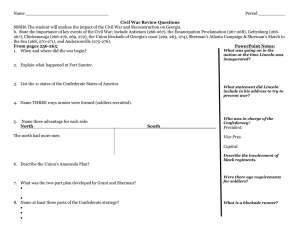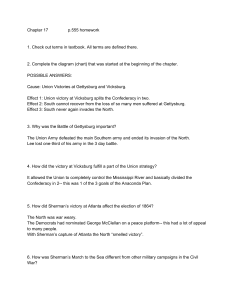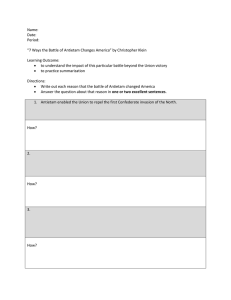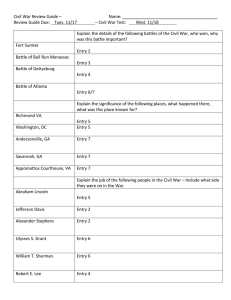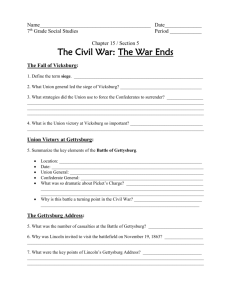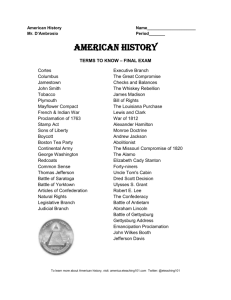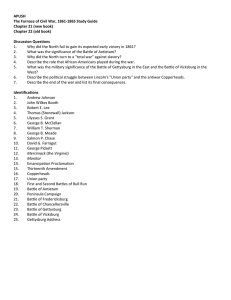Major Battles and Figures of the Civil War
advertisement
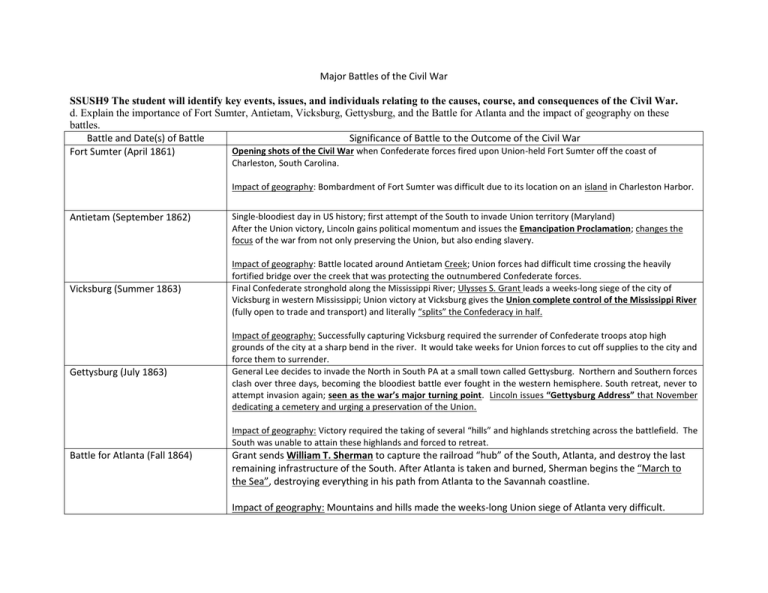
Major Battles of the Civil War SSUSH9 The student will identify key events, issues, and individuals relating to the causes, course, and consequences of the Civil War. d. Explain the importance of Fort Sumter, Antietam, Vicksburg, Gettysburg, and the Battle for Atlanta and the impact of geography on these battles. Battle and Date(s) of Battle Significance of Battle to the Outcome of the Civil War Opening shots of the Civil War when Confederate forces fired upon Union-held Fort Sumter off the coast of Fort Sumter (April 1861) Charleston, South Carolina. Impact of geography: Bombardment of Fort Sumter was difficult due to its location on an island in Charleston Harbor. Antietam (September 1862) Single-bloodiest day in US history; first attempt of the South to invade Union territory (Maryland) After the Union victory, Lincoln gains political momentum and issues the Emancipation Proclamation; changes the focus of the war from not only preserving the Union, but also ending slavery. Vicksburg (Summer 1863) Impact of geography: Battle located around Antietam Creek; Union forces had difficult time crossing the heavily fortified bridge over the creek that was protecting the outnumbered Confederate forces. Final Confederate stronghold along the Mississippi River; Ulysses S. Grant leads a weeks-long siege of the city of Vicksburg in western Mississippi; Union victory at Vicksburg gives the Union complete control of the Mississippi River (fully open to trade and transport) and literally “splits” the Confederacy in half. Gettysburg (July 1863) Impact of geography: Successfully capturing Vicksburg required the surrender of Confederate troops atop high grounds of the city at a sharp bend in the river. It would take weeks for Union forces to cut off supplies to the city and force them to surrender. General Lee decides to invade the North in South PA at a small town called Gettysburg. Northern and Southern forces clash over three days, becoming the bloodiest battle ever fought in the western hemisphere. South retreat, never to attempt invasion again; seen as the war’s major turning point. Lincoln issues “Gettysburg Address” that November dedicating a cemetery and urging a preservation of the Union. Impact of geography: Victory required the taking of several “hills” and highlands stretching across the battlefield. The South was unable to attain these highlands and forced to retreat. Battle for Atlanta (Fall 1864) Grant sends William T. Sherman to capture the railroad “hub” of the South, Atlanta, and destroy the last remaining infrastructure of the South. After Atlanta is taken and burned, Sherman begins the “March to the Sea”, destroying everything in his path from Atlanta to the Savannah coastline. Impact of geography: Mountains and hills made the weeks-long Union siege of Atlanta very difficult. Major Figures of the Civil War SSUSH9 The student will identify key events, issues, and individuals relating to the causes, course, and consequences of the Civil War. c. Describe the roles of Ulysses Grant, Robert E. Lee, “Stonewall” Jackson, William T. Sherman, and Jefferson Davis. Individual Description of their role in the Civil War Ulysses S. Grant Robert E. Lee “Stonewall” Jackson William T. Sherman Jefferson Davis
